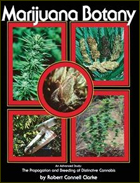
by Robert Connell Clarke
Introduction
Cannabis, commonly known in the United States as marijuana, is a wondrous plant an ancient plant and an ally of humanity for over ten thousand years. The profound impact Cannabis has had on the development and spread of civilization and conversely, the profound effects we’ve had on the plant’s evolution are just now being discovered.
Cannabis was one of the earliest and most important plants placed under cultivation by prehistoric Asian peoples. Virtually every part of the plant is usable. From the stem comes hemp, a very long, strong fiber used to make rope, cloth, and paper renowned for durability. The dried leaves and flowers become the euphoriant, marijuana, and along with the root, are also used for numerous medicines. The seeds were a staple food in ancient China, one of their major “grains.” Cannabis seeds are somewhat unpalatable and are now cultivated mainly for oil or for animal feed. The oil is similar to linseed and is used for paint and varnish making, fuel, and lubrication.
Cultivated Cannabis quickly spread westward from its native Asia and by Roman times hemp was grown in almost every European country. In Africa, marijuana was the preferred product, smoked both ritually and for pleasure. When the first colonists came to America they, quite naturally, brought hemp seed with them for rope and home-spun cloth. Hemp fiber for ships’ rigging was so important to the English navy that colonists were paid bounties to grow hemp and in some states, penalties were imposed on those who didn’t. Prior to the Civil War, the hemp industry was second only to cotton in the South.
Today, Cannabis grows around the world and is, in fact, considered the most widely distributed of all cultivated plants, a testimony to the plant’s tenacity and adaptable nature as well as to its usefulness and economic value. Unlike many plants, Cannabis never lost the ability to flourish without human help despite, perhaps, six millennia of cultivation.
Whenever ecological circumstances permit, the plants readily “escape” cultivation by becoming weedy and establishing “wild” populations. Weedy Cannabis, descended from the bygone hemp industry, grows in all but the more arid areas of the United States. Unfortunately, these weeds usually make a very poor grade marijuana.
Such an adaptable plant, brought to a wide range of environments, and cultivated and bred for a multitude of products, understandably evolved a great number of distinctive strains or varieties, each one uniquely suited to local needs and growing conditions. Many of these varieties may be lost through extinction and hybridization unless a concerted effort is made to preserve them. This book provides the basis for such an undertaking.
There are likely more varieties of marijuana being grown or held as seeds in this country than any other. While traditional marijuana growers in Asia and Africa, typically, grow the same, single variety their forebears grew, American growers seek and embrace varieties from all parts of the world. Very potent, early-flowering varieties are especially prized because they can complete maturation even in the northernmost states. The Cannabis stock in the United Nations seed bank is at best, depleted and in disarray. American growers are in the best position to prevent further loss of valuable varieties by saving, cataloguing, and propagating their seeds.
Marijuana Botany-the Propagation and Breeding of Distinctive Cannabis is an important and most welcome book. Its main thrust is the presentation of the scientific and horticultural principles, along with their practical applications, necessary for the breeding and propagation of Cannabis and in particular, marijuana. This book will appeal not only to the professional researcher, but to the marijuana enthusiast or anyone with an eye to the future of Cannabis products.
To marijuana growers who wish to improve or upgrade their varieties, the book is an invaluable reference. Basic theories and practices for breeding pure stock or hybrids, cloning, grafting, or breeding to improve qualities such as potency or yield, are covered in a clear, easy-to-follow text which is liberally complemented with drawings, charts, and graphs by the author. Rob Clarke’s drawings reflect his love of Cannabis. They sensitively capture the plant’s elegance and ever-changing beauty while being always informative and accurately rendered.
The reader not familiar with botanical terms need not be intimidated by a quick glance at the text. All terms are defined when they are introduced and there is also a glossary with definitions geared to usage. Anyone familiar with the plant will easily adopt the botanical terms.
Years from now, many a marijuana smoker may unknowingly be indebted to this book for the exotic varieties that will be preserved and new ones that will be developed. Growers will especially appreciate the expert information on marijuana propagation and breeding so attractively and clearly presented.

